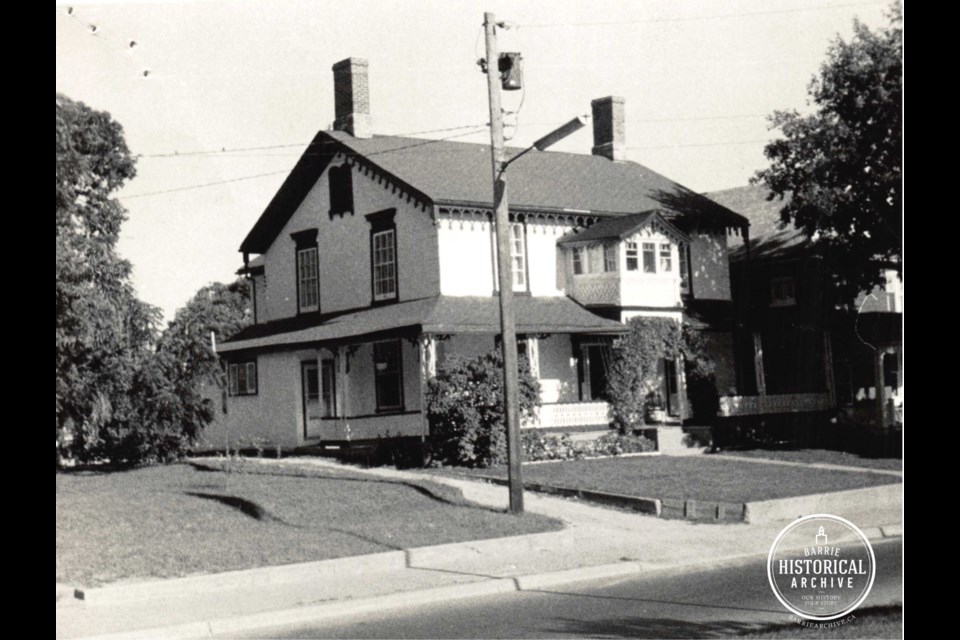This ongoing series from Barrie Historical Archive curator Deb Exel shows old photos from the collection and one from the present day, as well as the story behind them.
Roselawn — 9 Bradford St.
Maj. Joseph Rogers probably had the best lawn ornament on the block – a working cannon!
His story starts in Leeds, County of York, England in 1833. Growing up, Rogers attended Spofforth boarding school near Weatherby, in magnificent steeplechase country. At 18, he departed Liverpool for New York on the ship the West Point.
The passage was an unpleasant one, in many ways. The ship was carrying 350 passengers from Ireland in steerage – 17 of whom died during the trip. Sickness broke out when the water supply was exhausted, they encountered storms near Newfoundland, and sailors robbed Rogers of all his money.
Rogers arrived in New York completely broke, nine weeks and four days after leaving England.
Nonetheless, Rogers worked his way to Toronto, then rode a construction train to the end of the line: Bradford. The next morning, he took the steamer Beaver over to O’Brien’s dock in Shanty Bay. Rogers worked on his uncle’s farm in Oro for a period of time, attending St. Thomas’ church and singing in the choir.
About 1852, when he was 19, Rogers joined the militia and his commission dates to 1856 when he made Ensign in the No. 1 Rifle Company. He was a lieutenant in 1860 with the Queen’s Own Rifles, until they dissolved and he transferred to the 35th Battalion Simcoe Foresters.
The first colours of the battalion, by the way, were embroidered by Mrs. Rogers, the former Miss Ann Whitebread whose family were wheelwrights and carriage makers, their home and shop were located at 134 Collier St. Rogers remained with the Simcoe Foresters for 16 years, rising to paymaster and major, earning five medals throughout his service.
It turned out that farm living was not the life for Rogers. He moved to town and took a job as assistant to John McWatt the postmaster. Later, he started work in the registry office eventually appointed high constable in 1864. Rogers acted as constable, bailiff, copyist and auctioneer for the town and county. Among his routine notices of insolvency, etc., the following item in the Sept. 2, 1869 newspaper stood out:
$100 REWARD!
The undersigned will pay One Hundred Dollars to the person who poisoned his dog on Monday last. If the poisoner, besides admitting his guilt, can substantiate the fact of his being the poisoner, no proceeding at law will be instituted against him, and he shall receive the reward offered.
Joseph Rogers
Ann and Joseph’s home at 9 Bradford St. was built in 1865. The Rogers property at one time extended up to Elizabeth Street (now Dunlop Street) and back to Toronto Street and the house originally had a verandah on three sides. This photo, from about 1900, although it’s difficult to see any details very clearly, suggests the second-floor porch and other changes would have occurred later.
The grounds of 9 Bradford St. were quite beautiful and the Rogers family held many lovely social events there over the years. Joseph Rogers was a keen horticulturalist, specializing in roses, hence the name Roselawn for their attractive home.
Joseph Rogers worked until he was 85 when poor eyesight drove him into retirement after more than 60 years of service. He had retired from the Simcoe Foresters in 1897, retaining his honorary rank of major. On June 26, 1930, the cheerful, popular Barrie pioneer, Maj. Joseph Rogers, passed away in his 98th year.
Although he was living with his son in Oakville at the time of his death, Maj. Rogers was returned to Barrie for a service at Trinity Anglican Church, where he had been a member of the choir for many years and a warden of the church. The Signaller’s’ Band from Camp Borden led the funeral procession from the church to Barrie Union Cemetery, where Maj. Rogers was buried with full military honours by the 'A' Company of the Simcoe Foresters and the Barrie Royal Canadian Legion.
At the graveside service, 12 legionnaires fired three volleys over the grave while a bugler sounded the Last Post. A very fitting tribute and send off for the beloved major.
A couple names of interest of other former occupants or owners of Roselawn. First, Robert Fletcher in 1897, the same year he sold his home on High Street to the hospital board for $3,000 so it could become Barrie’s ‘new’ general hospital.
The other is Hampton Jory in 1919. Jory, an insurance agent, was chairman of the “greatest and grandest celebration in the history of Barrie” on June 22, 1911 – a Coronation Day to celebrate King George’s ascension to the throne. King George, while still the Duke of Cornwall, had stopped in Barrie on Oct. 10, 1901, so for the town of Barrie, the royal connection had been established.
For about 40 years, from the 1930s until the 1970s, the gracious home, with its decorative and fanciful features, was known as the Roselawn Apartments, before it transitioned to a commercial property.
It still retains its distinctive architectural features to this day.
So… whatever happened to the cannon? Perhaps the Simcoe Foresters know.



